

ÅTTA GRADER/ SAMTIDA KONST OM SKOGEN
ÅTTA GRADER/ SAMTIDA KONST OM SKOGEN
ÅTTA GRADER/ SAMTIDA KONST OM SKOGEN
ÅTTA GRADER/ SAMTIDA KONST OM SKOGEN


PÅGÅR TILL 7 APRIL
PÅGÅR
LOULOU CHERINET/ STATE DESIGN
LOULOU




ÅTTA GRADER/ SAMTIDA KONST OM SKOGEN
ÅTTA GRADER/ SAMTIDA KONST OM SKOGEN
ÅTTA GRADER/ SAMTIDA KONST OM SKOGEN
ÅTTA GRADER/ SAMTIDA KONST OM SKOGEN


PÅGÅR TILL 7 APRIL
PÅGÅR
LOULOU CHERINET/ STATE DESIGN
LOULOU


EDITOR-IN-CHIEF
ALICE MÁSELNÍKOVÁ
EDITORIAL BOARD
ALICE MÁSELNÍKOVÁ, STUART MAYES, PONTUS RAUD, ANDREAS RIBBUNG
CONTRIBUTING WRITERS
ALICE MÁSELNÍKOVÁ, ELLEN HOCHBERG, SWEDISH GIRLS (MIRA BERGH & JOSEFIN ZACHRISSON), RINA EIDE LØVAASEN, NAN EMBÄCK, SEASLUG (LAUS ØSTERGAARD, KATINKA SAARNAK, ALI RAZZAK, FANNY BYLUND), ICHIRO IRIE
CONTRIBUTING ARTISTS & PHOTOGRAPHERS
ALICE MÁSELNÍKOVÁ (5 –7 ), BASE CAMP STUDIOS (9), PRISCILLA DOBLER DZUL (10), MADART STUDIO (10), COLUMBIA CITY GALLERY (11), SHIFT GALLERY (12), SIDERAIL COLLECTIVE (13), WA NA WARI (14), DAWN ENDEAN (15), BASE CAMP STUDIOS (16), HOLE IN THE AIR (17 ), ELIAICHI KIMARO, ELLEN HOCHBERG, CRISTA MATTESON, DAWN ENDEAN, STEPHANIE HARGRAVE, CAROLYN AUTENIETH, ROSALIE FRANKEL, THERESA NEINAS, MARILYN CHARLAT DIX (18), SWEDISH GIRLS (21–24), BENJAMIN ANDERSSON (25), RINA BELDO (25), LARS EMBÄCK (26), MARGARETHA OLSSON (27 ), RINA BELDO (27–28), LENA IGNESTAM (28), SEASLUG (29 –33), MADHAT KAKEI (30), ANSELM KIEFER (31), LAUS ØSTERGAARD (33), DURDEN AND RAY (35), QIPO FAIR (35 –36, 38, 44, 46), LA PANADERÍA (36), RIM MAGAZINE (36), MARK DEAN VECA (38), KIEL JOHNSON (38), JAUS (38), TITANIK-GALLERIA (40), LONG LONG AND THE KELLIES (40), PØST (40), ARENA 1 (40), TRYST ALTERNATIVE ART FAIR (40), THE REEF (42), AWOL (46), FARM & DISTILLERY (46), PUNTO MAGNOLIA (46), DURDEN AND RAY (46)
GRAPHIC DESIGN
KATHARINA PETER
LANGUAGE EDITING AND PROOFREADING ALICE MÁSELNÍKOVÁ, STUART MAYES
ADVERTISING SALES
NADJA EKMAN
ADVERTISING CONTACT
AD@SUPERMARKETARTFAIR.COM
PRINTING
PRINTON TRUKIKODA LTD
PUBLISHER
PONTUS RAUD
Cover image: Carolina Sandvik, ‘The Lovers’, stop motion animation, 13 min, 2023; featured at SUPERMARKET 2024 by DIGITALISEUM
Alice Máselníková
Creative director, Meetings Expanded, Talks & Performance and Forum coordinator

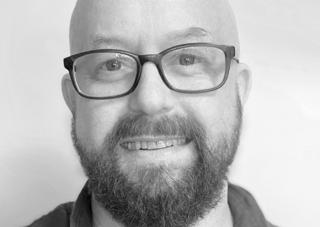
Andreas Ribbung
Creative director

Stuart Mayes Meetings coordinator Proofreader and language editor
Stuart is a visual artist living and working in Uppsala, Sweden. In addition to his studio and project practice he is the curatorial technician for Region Uppsala. He studied at Dartington College of Arts and the Slade School of Fine Art as well as taking courses at Konstfack and the Royal Institute of Art Stockholm. Stuart has been a proofreader and language editor for Supermarket Catalogue and Art Magazine since 2012 and the Meetings Coordinator since 2020. He has a passion for glitter and a growing collection of silk scarves and ties. Dreams of: being with everyone, everywhere, always
Ida is a socially minded team player, art consumer and gamer. Former student of art history, she spent two turns as a volunteer at Supermarket before joining the team. Daytime dressed up as a union worker, her passion arises at night. Investigating the relationship between objects and humans she delves into the secret language of the thing. Dreams of: everyone to realise how incredibly amazing every single person on this blue orb of ours is
Alice is a Czech visual artist based somewhere in the middle of the Swedish wilderness. Out of the three creative directors of Supermarket she is the one with the most hair and least beard. Also the editor of Supermarket Art Magazine. She is the initiator of the artist-run initiative Flat Octopus and works as a freelance curator and cultural funding advisor. When she is not working or painting you are likely to find her lost in a book or drafting a new poem on her Olympia SM4 typewriter. Dreams of: taking the right path in the woods
Andreas is co-founder and one of the three creative directors of Supermarket. He is a painter and besides working with his own art, he is involved in the artistrun exhibition space Candyland and active as a project leader and adviser on art in the public realm, at the moment for the municipality of Östersund, and the Regional Councils of Stockholm and Kalmar County. He is the father of four wonderful daughters and a dedicated gastro-hedonist. Dreams of: hedonistic cooking sessions

Belinda is currently obsessed with videoworks, running and strobe lightning. She is one of the founders of the artist-run collective Best Before Collective and active with her own artistic practice. At the Supermarket Belinda is the tour guide and manages the creative workshop for young people. When she’s not out and about she’s at home rewatching Seinfeld episodes. Dreams of: peace, love and understanding

Pontus is a visual artist and curator based in Stockholm. Initiator and co-founder of Supermarket and today one of the three creative directors. He is active as a curator and will in the autumn move to the sea and begin a new job as art process manager in Halmstad municipality. Alongside this he is a member of the artist collective KKV. Dreams of: the return of Globalism

Expanded coordinator

Elin is a nature obsessed, multimedia artist and artisan who equates creating with breathing. She studies ethnology, and is interested in and inspired by the ways art impacts and connects us to the world, each other and ourselves. She joined Supermarket in 2022 as a volunteer before taking on her current position. Dreams of: thread and all the shapes and patterns it can make

Felicia is Supermarket's very own spin doctor and communications officer with a passion for the written word and spectacular imagery. She has been part of the Supermarket team since 2017, and in 2020 she became a member of studio collective and art platform Detroit Stockholm. Felicia holds a BA degree in Media & Communications from Stockholm University, and she further studied graphic design at Konstfack, Konstskolan Basis and Södertörns högskola. Dreams of: a miracle fix
Veronika is an artist working primarily around the notions of body adornment in relation to sound. She is one of the contributing editors for the Current Obsession magazine and the founder of the Undisciplined series promoting transdisciplinary craft practices. She has been a part of Supermarket since 2021. Dreams of: a world without 9 to 5 jobs

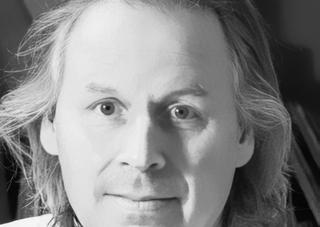
Ruoxi is currently studying the International Master's Programme in Curating, including Art, Management, and Law, at Stockholm University. She completed her Bachelor's degree in Art History at Queen's University in Canada. Following her studies, she worked as an assistant curator and product designer at the Imperial Palace Museum of the Qing Dynasty in China. She is a co-founder of the social media account Curator To-Go, established in 2020, which introduces international contemporary artists to Chinese audiences. She currently collaborates with Stockholm University's International Office and Nordic Business House (NBH) as a Chinese Student Ambassador. Dreams of: having a Devon Rex cat or Westie puppy
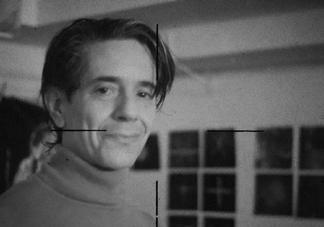
José studied photography at the University Escuela De Artes Lino Enea Spilimbergo. Following his studies he worked as a freelance press photographer, which included many trips to various countries in Latin America. Since 2000, José has been based in Stockholm and works especially with still images and film with commissions from the performing arts field, cultural sector, press and media as well as commissioned portraits. For his own projects, he allows himself to be attracted by lavish events. Dreams of: a ride to the moon

Katharina is an independent graphic designer and after working on several art and culture projects in Sweden and Austria she got to know Supermarket and was hooked. Most of her projects start with a pencil and then they continue as a combination of all sorts of manual and digital techniques which finally result on paper. She now lives and works in Switzerland. Dreams of: seemingly endless frozen lakes in winter for ice skating

Kenneth is an independent artist, curator and the cofounder of Being in The World, an interdisciplinary network exploring topics through dialogue and production of new art, and he further studied art and painting at Konstfack, and the Royal Institute of Art in Stockholm. He has been part of the Supermarket team on and off since 2008. He is mainly a painter but periodically he also works with sculpture, printmaking and combining them in installations. He is always looking for new ways to depict outlooks on the world and the phenomenology of being. Dreams of: creating the perfect piece of art that authentically captures the feeling and presence of being and can communicate without the need for any text

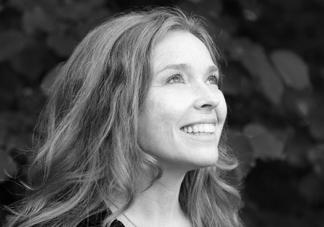
Hanna is a singing web designer who, in addition to web design, has studied sustainability, risk and decision theory, and rhetoric. Starting up her web career in the beginning of the 20th century she has had a keen interest in following the most recent innovations concerning web design. That has been keeping her quite busy, but since 2002 she has also been touring all over the world with a famous Swedish piano player, singing in a vocal trio called the Vocalettes. In the future when she has some spare time she is planning to save the world. Dreams of: clarity
John is a Helsinki-based artist who works primarily in open-form collaboration and experimental cultural platform design. Previously, he was the co-instigator of Biathlon, a toolkit for operating collectively-run spaces, which ran in Helsinki from 2016–2018. He was co-director of the 2015 Pixelache festival, operated the Ptarmigan platform from 2009–2014, and has performed and released music with various projects. Later this year he is launching a centre for heterodox research into technology and culture production, located in a former railway station in the Estonian countryside. Dreams of: the luddites of the world to first unite, and then take charge of everything
Nadja is a photographer, inventor, co-founder of Candyland and a member of Glimpse mobile studio. As soon she has time, she does a new episode of ‘Move My Food’ which an experimental play with stop-motion and food. Three days a week she teaches children and young people at the Stockholm School of the Arts in Husby and Rinkeby and a few months a year she sells advertising space in the Supermarket Art Magazine. Dreams of: an earth in balance





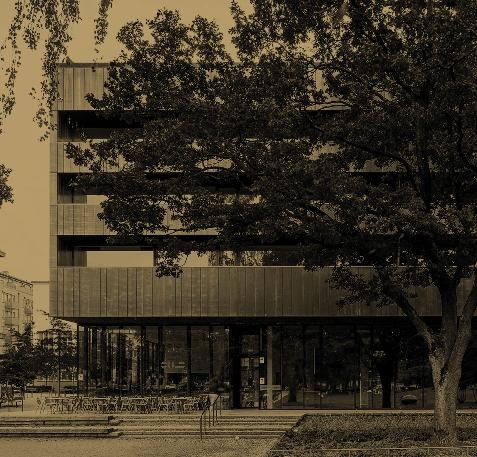
3.5–18.5
Exam exhibition
Bachelor in fine arts
3.5–12.5
Annual exhibition
All students present their work
21.5–28.5
MFAAR exhibition
Master in Fine Arts and Artistic Research
31.5
Nairy Baghramian Honorary Doctor

PhD Candidates:
Sven Augustijnen
Yael Bartana
Jürgen Bock
Bouchra Kahlili
Emily Wardill
Jacob Korczynski
Honorary Doctors:
External Tutors:
Charif Benhelima
Nina Roos
Ann Böttcher
Marie Muracciole
Daniele Di Girolamo, Beautiful Things Fading Away. 2023. MFA exhibition. Photo: Youngjae Lih. Rector: Maj Hasager Professors: Alejandro Cesarco Verina Gfader Joachim Koester Sarat Maharaj Gertrud Sandqvist Fredrik Vaerslev Maj Hasager Senior Lecturer: Maria Hedlund Youngjae Lih Junior Lecturer: Gabriel Karlsson Joakim Sandqvist Mary Kelly Helmo Zobernig Nairy Baghramian1 Editorial Team
3 Supermarket 2024 Team
6 Editorial: On Dreams / Dream On
Alice Máselníková
9 Spotlight on USA: Artist-Run Scene on the West Coast
Ellen Hochberg
21 Swedish Girls! Dreaming of Swedish Girls
Swedish Girls: Mira Bergh & Josefin Zachrisson
25 Malmö Open Studios
Rina Eide Løvaasen and Nan Embäck
29 Interview With Seaslug: Laus Østergaard, Katinka Saarnak, Ali Razzak & Fanny Bylund
Alice Máselníková
35 The Transnational Community of Artist-Run Initiatives, QiPO Fair and Me
Ichiro Irie, Creative Director, QiPO Fair


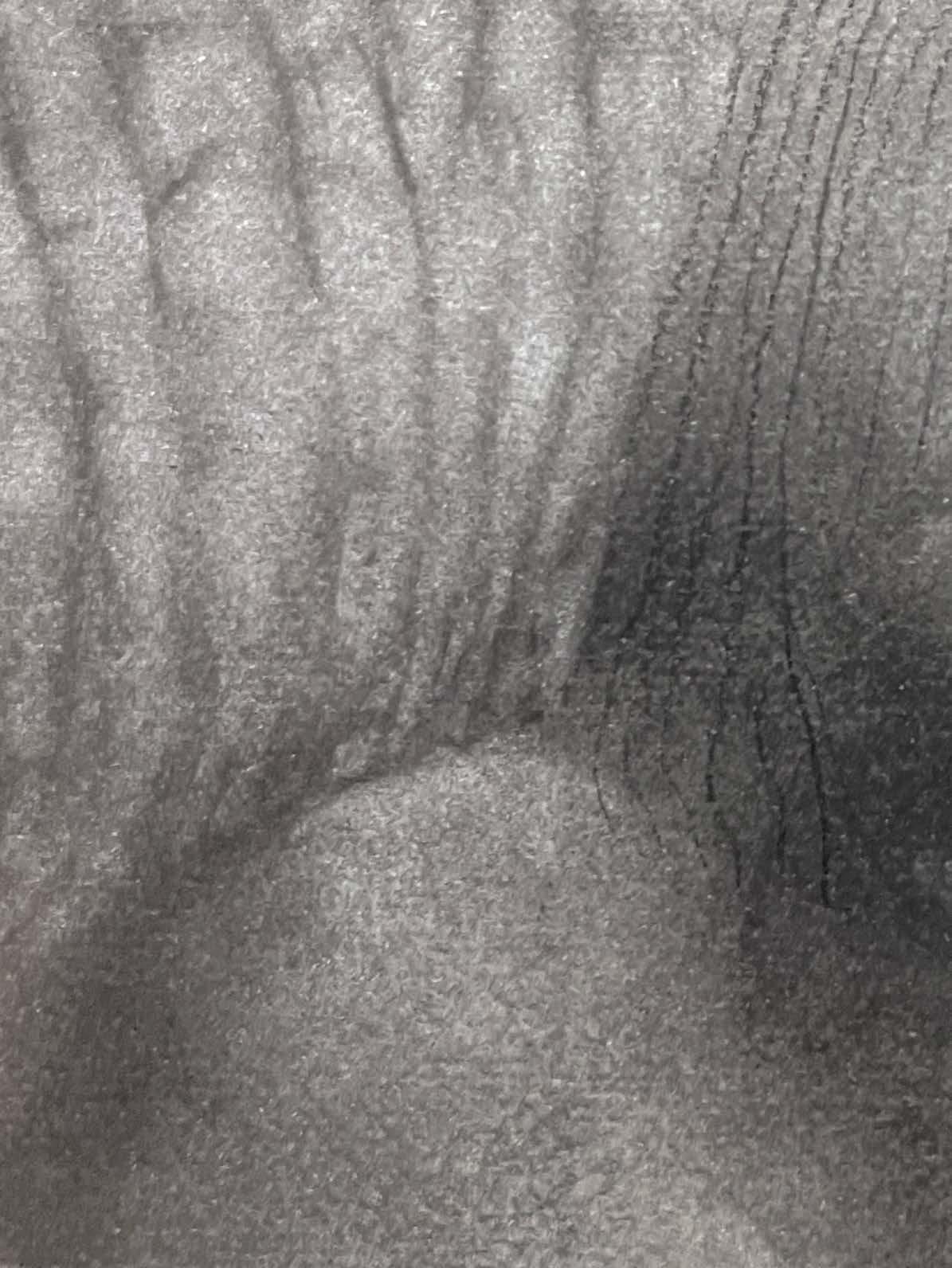
The Sandman is coming, it’s time to sleep;
lest he plucks out your eyes – eats up your dreams.
Sandman is not your favourite night companion. He sneaks up on you when you cannot sleep and throws sand in your eyes as a punishment to make them bleed and fall out, and then collects them to feed his hungry beak-nosed children who sit perched on the crescent moon. Or so goes the tale of the Sandman based on an old German myth and popularised by E.T. A. Hoffmann in the short story Der Sandmann. There are more bedtime-friendly versions of Sandman’s character, where he sprinkles good dreams into children’s eyes, but well…I rather bet it is the bad sprinkles.
It is fascinating how much dreams can impact our lives well beyond the realm of sleep. Hoffmann’s Sandman story is
inspired by the epidemic of sleeping sickness, encephalitis lethargica, that occurred between 1915 and 1926 (different to the tsetse fly-transferred sleeping sickness we talk of in the 21st century). First appearing in Vienna, it affected about one million people, killed over half a million, and left hundreds of thousands disabled before suddenly disappearing again. The real cause still remains uncertain today. Numerous works of art have been influenced by our disturbed dreamworld, for example by the condition known as sleep paralysis (one of the most famous artworks is the painting ‘The Nightmare’, 1782, by the Swiss painter Heinrich Füssli). In sleep paralysis one is fully awake and conscious, but completely paralysed and unable to move or speak. Though

the reasons are not completely known, it is thought to appear in between sleep stages. Often, the affected person is gripped by utter panic alongside a feeling that someone is in the room watching or sitting on their chest. If you have not experienced this, I do not wish it upon you.
So yes, we know that sleep does not guarantee good dreams. For centuries it has been thought that dreams are channelled through us by gods to show us their will and design. Alternatively, a less poetic version proposed by Aristotle, dreams could just be caused by indigestion. Whether they come from higher powers or too much cheese, what would we be left with if we couldn't dream up other, better worlds – ones we cannot reach, but that reach deep inside of us?
I read recently about a new trend on TikTok, one of the many that come and disappear without anyone in the outside world taking much notice. The one I stumbled across is that of “#soft life” – largely connected to and promoted by “#soft girls”. The trend romanticises the daily reality in a wish for a harmonious existence in tune with nature, embracing one’s feminine energy, and focusing on well-being and self-care, as opposed to burdening oneself with thoughts of economic pressure. Images of beautiful women with silky hair and smooth skin wearing pastel-coloured dresses lying in a field of sunflowers, meditating on top of a mountain or serving delicious organically sourced dinners pop up when you search the tag.
However silly the TikTok’s formulation sounds, and notwithstanding other connotations of the trend, the idea of a perfect relaxed life revolting against continuous life-draining labour has been here for centuries. The Romanticism movement of 18th–19th century with Walden escaping into the woods to build his lonesome hut, searching for rawness of existence at the same time as meticulously accounting in his diary for every nail and screw he had used; the flâneurs leisurely wandering the streets without an aim or a worry under their top hats, or more recently the rebellious free-spirited hippie boomers believing that the world will improve with them. I think that TikTok as a massive platform offers a rather acute microcosm of the moods and shifts in society. With market prices continuously on the rise, economic instability for the young, threats of war, pandemic and environmental issues constantly highlighted by the media – who of us can say we have not been tempted to just be, cherish our inner goddess and float on a dream cloud?
The capacity to dream is one of the most beautiful gifts we have. Dreams predict the future and shape the past. Dreaming is limitless and ultimate; it disregards the circumstantial and summons the inspirational – love, terror
and beauty in the split of a second, but also for eternity. We can laugh at the silliness of the unrealistic dreamers: the ‘soft girl’, the artist, the poet, the longing lover, but with a pinch of envy for a vision which escapes us, for a universe a pragmatic cannot inhabit.
The articles presented in this edition have a shared thread of dreams and visions being realised. One such example is the journey of starting an artist-run fair in Mexico City, the QiPO art fair, and the captivating motivation and background of the event written by artist and the fair’s organiser Ichiro Irie.
Dreamers from the waterlands that is Seaslug, Stockholm’s youngest and most active online art guide. We interviewed Laus Østergaard, Katinka Saarnak, Ali Razzak and Fanny Bylund about their motivation for starting the platform, as well as what their aims have been and what the future tides might bring.
The article by Rina Eide Løvaasen and Nan Embäck presents Malmö Open Studios, yet another visionary project initiated to strengthen and make visible artists who are based in Malmö. Inspired by a similar initiative in Norway, Oslo Open, MOS has contributed to numerous artists showing their work to a large audience, and has put Malmö’s art scene on the contemporary art map.
The artist duo Swedish Girls have not slept for months and their special insert takes you into a world of juicy gossip and slander, making your legs shiver with information you did not know you need. But who are Swedish Girls? –Who knows! Maybe you will find out! And maybe you meet them in person at Supermarket (beware).
In the article Spotlight on USA, artist Ellen Hochberg presents the self-made dream of artist-run spaces on the American west coast. Find out in this extensive summary what the independent art scene looks like, how it is organised and what challenges the artists face across the ocean.
With Supermarket 2024’s theme Dream On we evoke both your inner dreamer and inner sceptic, the naive and the sensible. Let them converse and fight. Time is too short to not dream as much as we can – however brazen our dreams may be. Protect your dreams at all cost; listen and challenge them, but do not let anyone steal them. Dream up your castle, and let it collapse gracefully.
I hope you enjoy this year’s art fair and the magazine, and that you encounter art and artists here at Supermarket 2024 who give you something to dream about.
A lice Máselníková, Editor-in-chief, Creative director Alice Máselníková, ‘Introspection’, charcoal, sienna and pencil on paper, 15 x 15 cm, 2023Kunstkritikk – Nordisk kunsttidsskrift
Låt flera av Sveriges kunnigaste skribenter guida dig genom konsten. Analyser, kommentarer, reportage och ett rikt bildmaterial hjälper dig att hålla koll på aktuella trender, utställningar och konstnärer både i Sverige och i världen.




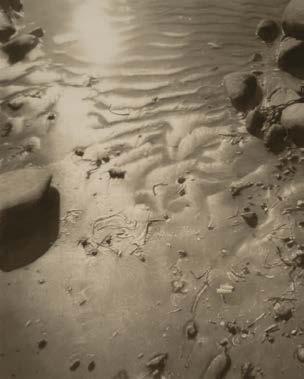
Kunstkritikk – Nordic Art Review
Som medlem i Svenska Fotografers Förbund kan du söka flera stipendier varje år till ett värde av ca 200 000 kronor. Sök våra rese- och utbildningsstipendier eller våra vistelsestipendier till Grez-sur-Loing eller Paris. Eller till vackra Kavalla i Grekland!
Läs mer på sfoto.se!
SVENSKA FOTOGRAFERS FÖRBUND

Self-organised, artist-run initiatives – those run by the artists themselves – are characterised by their non-institutional way of organising, their flat hierarchy, and often experimental formats. Supermarket art fair gives us the opportunity to learn from each other. How are other groups organised, how do they manage funding, where do they show their work and how often, and how are members selected? These are just some of the questions we ask ourselves when we put together an artist-led group.
Artist Ellen Hochberg currently works in Seattle, Washington, located on the west coast of the United States. She
reached out to some artist-run groups in her community to learn how they answer these questions.
Arts visionary and philanthropist Alison Wyckoff Milliman founded MadArt in 2009. Her vision of facilitating accessible art experiences by supporting artists in creating new works has been a guiding pillar since MadArt’s inaugural show – a group exhibition in Seattle’s Madison Park neighbourhood which involved Milliman garnering the cooperation of shop owners who relinquished their prime storefront windows for art installations.
After this show, MadArt’s nomadic programming continued in a variety of public and non-traditional spaces, including houses slated for demolition, a public park, and the University of Washington’s campus. Through these temporary outdoor exhibitions, it became clear that not only were public audiences interested in the making aspect of the creative process, but there was a need from artists for studio space in order to build on a larger scale.
This led to a programmatic expansion that resulted in MadArt Studio, a site-responsive, installation-based exhibition space in South Lake Union. Situated in an architecturally distinct 1920s masonry-and-wood building the studio offers a collaborative platform for unique, engaging, and immersive art experiences. Participating artists are encouraged to make works that expand their professional practices and are given the space and support to do so. Each project is temporary and built on-site, starting with an Open Studio period that provides access into artmaking, and culminating in a traditional exhibition. Between (and sometimes during) exhibitions, MadArt Studio also serves as a unique urban event venue, providing a modern space for weddings, corporate events, intimate dinners, and nonprofit fundraisers. Rental proceeds directly support future artists and programming. This allows MadArt to remain free and open to the public during all phases of exhibition construction, demystifying the creative process and giving visitors and artists the opportunity to engage directly with one another amidst the artwork.
MadArt is one of the few art spaces that asks artists “What would you do if you could do anything in this space?” and then pays them to do just that. Each project is built entirely on-site and lives only for the duration of the exhibit, usually
a few months. With its tall ceilings, brick walls and bounty of natural light, the 3.800-square-foot space is a playground for artists, who often have to work in small studio spaces as larger ones are much more expensive.
Also unique is how visitors are invited to stop by and witness the installations-in-progress before the exhibition officially opens. (Entry has always been free.)
Since 2014, more than 30 artists have used the space to maximal effect, building installations that ranged from the political to the whimsical and emotional, including light sculptures that made you feel like you’d stepped inside an arcade game, a gigantic sculpture of oversized pillows that were actually made of plaster and the re-creation of a childhood home with billowing blue fabrics.
Seattle artist Casey Curran made his first MadArt work in 2010, shortly after graduating from Cornish College of the Arts. He and a few other artists were given stipends to create temporary installations in Cal Anderson Park. Curran created a large disk of grass that visitors helped water and keep green throughout the summer. “It became a stage and a performance of care, and I think for me, MadArt has done this for Seattle as a whole,” Curran wrote in an email.
“MadArt was one of the few places left in Seattle that allowed artists to create massive installations that pushed boundaries of what was possible for emerging creatives,” Curran wrote. “We didn’t have to think about what might look good on a collector’s wall. We were given (I was given) a livable wage for the duration of the installation and I was able to use that as a springboard for greater more involved projects. It’s so important for artists to create work that isn’t constrained to [the cycle of] make-sell-make-sell. Otherwise, we’re left with Instagram tropes and AI hallucinations.”


Columbia City Gallery started in 1999 after a local dairy hired SEEDArts, the arts and cultural branch of the Southeast Effective Development nonprofit, to paint a mural. SEEDArts hired Carlos Callejo to design the large-scale mural and brought in local artists Joan Robbins and Deborah BigelowJohnson to grid and paint the design. “We kept having to go down to Columbia City and pick up the guy who designed it,” Robbins said. “We decided it looked like such a cute little neighbourhood that it needed a gallery.”
“As you can imagine it would be nearly impossible for 20 artists to collectively sign a lease and handle fiscal obligations,” Kathy Fowells, who acted as manager of the Columbia City Gallery from 2005 until becoming the director of SEEDArts in 2015, said. Instead, SEEDArts leased the building in the space that’s now the Columbia City Theater. But two years later, the building went up for sale. In 2002, SEEDArts launched a capital campaign and raised about $500.000 to purchase the building that the gallery still occupies. But the building was in bad shape when they bought it, and remodelling took almost a year — much longer than expected. The gallery temporarily closed. It re-opened in its current location in 2003.
The Gallery normally features two concurrent exhibits: a member’s gallery and a community gallery that features exhibits by local artist groups. Anyone can submit a proposal for the community gallery through the gallery’s website, and those guest artists receive 50% sales. “We’re very intentional about how we use community gallery space, whose voices we’re trying to uplift and amplify in that space. People who might not otherwise have access to gallery or exhibition spaces,” said gallery member Eliaichi Kimaro.
The gallery currently has 26 members. Members pay on a sliding scale of $75, $100 or $125/month. In exchange they
get 6, 9 or 12 shows per year and all members receive 70% of sales. The members are also asked to work in the gallery twice a month as well as meet as a group once a month to go over gallery business. The Gallery Manager is paid by SEED. There is an executive committee made up of volunteers: with a president, vice-president, treasurer, and secretary. Members may also serve on the Gift Shop, Marketing, Social Media, Website committees. “Maybe because of its artist co-op model, there’s a lot of sharing of resources and supporting each other in our learning and growing, coming to each other’s shows,” Kimaro said. “It’s just very generous and not competitive.” “You have this group of artists, and they interact and influence each other’s work to a certain extent,” Robbins said, “It’s something of a support system.” Besides rotating member exhibits, the gallery keeps work from all members upstairs. Anyone can view an artist’s work when the gallery is open, even if that artist is not on display and without an appointment. “Just knowing that anyone can go in and see my stuff is huge,” Kimaro said. “As a result of that, people have seen my work, and as a result of that I’ve gotten more shows.”
“The overall goal of SEEDArts is to help artists thrive,” Fowells said. Traditional commercial galleries often split sales 50/50 with artists. Columbia City Gallery’s co-op model means the artists receive 70% of every sale. The remainder goes toward the gallery’s operating costs. “By giving artists 70% of their sales, we’re hoping that they’ll keep working, keep engaged, and be able to make a living from their artwork,” Fowells said. The Gallery also has a gift shop which currently shows the work of 80 artists from all over the region. Gift shop artists are not gallery members so do not pay a monthly fee or are not asked to work in the Gallery. They receive a 50% commission for sold work.

Shift is an artist-run gallery that opened in December 2004 in the renovated Tashiro-Kaplan arts complex, an artist live/work building in the Pioneer Square district of Seattle. The gallery was founded by artists Garth Amundson, Stephen Chalmers, Cara Jaye, Pierre Gour and Joni Papp with the primary goal of creating more freedom for artists to exhibit outside of normal gallery structures. They aimed to support a cross-section of Northwest-area artists who work in a variety of media and who are dedicated to creating challenging and innovative art.
Shift exists as a space in which its member artists can test ideas, take risks, or refine directions that advance their work. Artists have the freedom to build an installation, show challenging or controversial work, stage a performance, or create other collaborative events. They may also participate in group exhibition opportunities and sales events that arise, for example, pop-up shows and the Seattle Art Fair (for an additional fee). Membership provides an opportunity to be involved in a community of artists who are dedicated to supporting each other and bringing new and engaging art to the community.
There are currently 21 full and half-share members who each pay a monthly fee which goes to pay for rent and other operating expenses. Each member shows their work and/or curates an exhibition during a one-month period each year. As a half-share member, they split the exhibition space with another half-share member. Members are responsible for paying dues for the entire calendar year even if they elect to
drop their membership before the year is out. Each member is obligated to cover the gallery sitting on Fridays and Saturdays for their own monthly show. All members take on defined responsibilities for various aspects of gallery operation. Members are expected to attend monthly membership meetings (currently held virtually) and be available physically during different times during the year to help support the operations of the gallery. Art sales are currently transacted directly by the artist (no commissions are collected by Shift), and all members are responsible for their own taxes and accounting.
Kate Cudney came to architecture from a background in art, design, and education. In 2015, she was looking for new office spaces for her firm when she came across a historic dance hall in the Georgetown neighbourhood of Seattle. Realising that she had been missing the company of other artists, and seeing the possibilities this space afforded, she created Side Rail Cooperative. It includes six working studios as well as a gallery, kitchen, and small flexi-use spaces. When she listed the available studios for rent on Craig’s list, she was taken by the overwhelming response and recognised the need to create a space like this. Her original goal was just to break even.
The website describes Side Rail as “dedicated to cultivating a supportive inclusive space for creative ideas and pursuits. We offer members and the community a no-commission and low fee environment to gather, create, collaborate, educate, share ideas and work.” The Collective meets once a month to plan upcoming events. Members pay a monthly fee to rent the studios and get a set number of days for personal events in the gallery. Rents are dependent on the size of the studio, and studios can be shared by up to two people. There is an ongoing open call to non-members to show work in the gallery. The only fee for these shows is a small hanging fee that is paid on a sliding scale. Those who can’t afford to rent space are dubbed non-members and are included in gallery events.
“Creating community is so important to our souls,” says Kate. The gallery has been used by members and non-members to teach classes, hold events, and host salons. They host a monthly Circle Singing event, holiday shows, figure drawing classes, and raku sessions. Event organisers determine the fee for each event. The gallery also participates in the monthly neighbourhood art walk, Art Attack.
Kate says that the shows take a lot of work, but they love the collaborative sense of it where everyone feels welcome – even someone who is just starting out. “This is a place where people can rediscover the joy of creating,” says Kate. “Where individuals of all ages and skill levels can come to experience art from practising makers and create their own works.”


Nestled in the central district of Seattle is a house typical for the neighbourhood but richly different for the treasure trove of art and creativity inside. The Wa Na Wari house is a home for Black belonging through art, historic preservation, and community connection.
In August 2019, Inye Wokoma, Elisheba Johnson, Rachel Kessler and Jill Freidberg opened the doors to Wa Na Wari, literally “Our Home,” in the Kalabari language, spoken in Nigeria. Wa Na Wari is located in the family home of co-founder, artist Wokoma. They wanted to use this house as a centre for Black culture and art. WaNaWari’s cultural mission is inseparable from its location in the heart of Seattle’s central district, the historic home of the city’s African American community.
The gallery has housed a range of art by Black artists, including oil paintings, sculptures, written poetry, the spoken word, and mixed media. Each of the pieces are selected by Wa Na Wari’s curator, Elisheba Johnson. “I choose artists I find exciting,” said Johnson. Shows consist of up to four artists at a time. Local, national, and international artists show work in multiple mediums. The shows don’t have themes. But Johnson works with the artists to select the work to show, and the work doesn’t have to be new. Wa Na Wari pays each artist a stipend.
Wa Na Wari hosts various programmes. Love Offering is a community meal programme that provides free-of-cost African diasporic and Native American-inspired cuisine, prepared by Black/Indigenous chefs, three days a week. Love Offering promotes economic stability for BIPOC chefs, increases access to nourishing meals, and cultivates community and a sense of belonging around cultural dishes.
Love Offering support comes from the City of Seattle Department of Neighbourhoods. Walk The Block, an annual outdoor visual and performing arts festival that transforms the central district homes, businesses, parks and porches, and other common spaces into art installations and performance sites. Participants enjoy visual 2D and sculptural art, video installations, live music, dance parties, community stories and more as they stroll the neighbourhood. The Central Area Cultural Ecosystem, 21st Century (CACE 21) is a community organising initiative that seeks to build community power and capacity amongst Black central district homeowners and Black cultural works to advocate for land use policies that lower the barriers to creating cultural spaces based on the WaNaWari model.
The Seattle Black Spatial Histories Institute is Wa Na Wari’s community story training programme. Over the course of two years, a community cohort works with a faculty of Black oral historians from around the country, as well as with local historians, archivists, geographers, librarians, and artists, to learn and explore the ethics, techniques, best practices, tensions, and dilemmas of community-based oral history and Black memory work. Cohort members acquire skills in archival research methods, audio recording techniques, oral history interviewing techniques, transcription, story editing, audio editing, and public art proposal and activation processes. In the first year they attend workshops, conduct research, visit archives, and record interviews with community members, preserving Seattle’s Black history for Seattle’s Black future.
The artist-in-residency programme offers selected artists a one-month long residency in the Wa Na Wari house — a home that has been a central part of Black community life in
Seattle for over 50 years and is currently an incubator for Black thought and creativity — where they can work and create new visual artwork. The new work will then be on view at Wa Na Wari for a two-month period after the residency. Each artist will also receive a stipend of $2.000. Emerging artists receive mentorship from established artists as part of their residency.
The BLOOM Food Justice Series brings together urban farmers, community gardeners, naturalists, young adults, city staff, and the broader community to consider food justice and food sovereignty in Seattle: these issues are especially relevant as BIPOC communities continue to feel the effects of the COVID-19 pandemic. Last summer they recruited 7-10 BIPOC youth ages 18-25 to participate in a training programme with a curriculum spanning Indigenous knowledge systems, Black Liberation, urban farming practices, plant medicines, the healing arts, ways to combat environmental racism and much more. BLOOM workshops, virtual talks and public programmes are open to community members free of cost. All virtual sessions are recorded and uploaded on Wa Na Wari and Seattle Public Library’s Youtube channels. The programming itself is sited at the Wa Na Wari Giving Garden. Wa Na Wari is funded through donations, fund-raisers, grants, and in collaboration with community partners.
Besides alternative gallery spaces, Seattle continues to host a variety of pop-up art exhibitions.
In Exploded View, curators Dawn Endean and Jane Richlovsky assembled a group of artists who are pushing the practice of printmaking beyond the two-dimensional plane, particularly in ways that dissect the thought process and mechanics of the medium.
The idea for the show evolved from a conversation the curators had about how printmaking is traditionally considered a two-dimensional medium, yet it always requires artists to think in layers, to separate colours, organise values, or build rich and complex imagery. They soon had a list of over a dozen printmakers whose work was following their thinking out of the two-dimensional plane and into all sorts of interesting places. They decided to bring the artists together into this show.
Exploded View commandeered the raw ground floor of a brand-new building on Seattle’s waterfront intended to house offices. The space was temporarily transformed into an art space. Richlovsky persuaded the developers, Urban Visions, to let the roughly 7.500-square-foot space be filled with art by Northwest makers. The weekend-long show ran concurrently with the Seattle Art Fair. Exploded View celebrated the three-dimensional application of printmaking techniques via sculpture, installation, video, and augmented reality.
Because of the size of the space, Richlovsky and Endean told the artists: “Don’t be afraid to go big” – and they weren’t! While some site-specific works weren’t for sale, a small store with affordable art prints provided take-home opportunities.


The exhibition Ghosts of Belltown shown at Base Camp Studios asks how vacant buildings might serve the communities where they are located. It also offers a glimpse of what can be achieved when artists and makers see a space anew. In this way, Ghosts of Belltown honours the multiple lives of a space and its occupants, the ghosts who knew it before, and a community eager to see it come alive once again.
Base Camp Studios founder Nick Ferderer turned the vacant Bergman Luggage building on Third Avenue and Stewart Street into a first-floor gallery, with the plan to build studios upstairs. Ghosts of Belltown is their first show in this location. Ferderer toured eight buildings to expand Base Camp Studios before settling on the vacant Bergman Luggage building. A real estate deal to replace the building with apartments had fallen through over the summer and it was up for grabs. Despite a rough appearance no other building had the same raw potential. Floor-to-ceiling windows of a former retail space – or potential for windows, as they’d all been blown out – were a natural fit for a gallery. Upstairs, where Ferderer plans to construct studios, had exposed brick walls and chipped plaster with a natural patina. “It just screams creativity and almost like you walked into a time capsule,” he said. “In a sense you have, it was vacant for a while.”
The renovation process on the main floor gallery took months and with the help of his construction worker father, who would come for the weekend from Ferderer’s hometown of Vancouver, Washington, Federer lugged objects down the stairs about 50 times a day and saw his daily step count rise from 10.000 to 21.000. Artists rearranged those abandoned raw materials into structural pieces for Base Camp Studios’ new exhibition, Ghosts of Belltown, which opened on 7 December.
Immersive installations like Ghosts of Belltown are the sort of work Ferderer wants to promote. He imagines six- to eight-week shows like this, with 30 artists working in low-rent studios upstairs though none are ready yet, but Ferderer said 18 artists have committed. He’s planning to lease them for between $2.50 and $3 per square foot. “That’s very intentional,” he said. “It’s important to have affordable studio space for creatives to create.”
Seattle is also home to some independent artists groups; groups who show and work together but do not have a permanent exhibition space.

Seattle artist Saundra Fleming loves intellectual conversations about art. In her search for like-minded artists, she put together a collective of artists from Seattle, South Carolina, New York, Tel Aviv, Serbia, and Germany. The group, Hole In The Air, describes themselves as an international art movement characterised by the experimental, the philosophical, and the search for the radical connections between artists.
They meet monthly via Zoom to discuss their work and to issue challenges to each other. The challenges have included: create something with chocolate; create an illustration for a poem; draw a self-portrait while brushing your teeth. Each artist shares their work with the group, and they post the results on their website. Saundra selects the members of the group. “I am looking for people who are curious. Who are intellectuals”. And she added, ‘Can we get along with them? “ she says. Last November the group had their inaugural show at Culterim Gallery in Berlin. “It was a great audience, and we had some great conversations,” said Fleming.
Below an excerpt from Seattle artist Jane Richlovsky’s TED talk on how to survive as an artist.
I have a story about real estate, but this one’s true and it’s mine. So, as I said, I’m a painter. I need a place to paint and for ten years I found it here in this building 619 Western Avenue in Seattle’s central waterfront area. In the early 80s it was an abandoned warehouse and a few artists moved in and then a couple more and over the course of 30 years it grew organically into the largest and longest-running all-arts building on the West coast.
In 2011, when our story takes place, there were about 120 artists working there. The building had been badly damaged in a 2001 earthquake. Damage that was never repaired because the owner had always planned to demolish the building – put up something more profitable. Something we knew going in. We knew that our dream house wasn’t going to be there forever. And also, not to get all 19th century Parisian or anything but it was a little bit draughty and rather dangerous. But we went into the bargain with our eyes open. We had cheap rent in exchange for temporary and rather dangerous conditions.
It’s a bargain struck by many artists in many other cities and many other times. My window looked out onto this mid-century viaduct which had been damaged in the same earthquake and was also dangerous. So, the state of Washington decided they wanted to replace this road with a tunnel underneath the middle of downtown Seattle. And in their studies, they found that the only building in the entire path of the tunnel that was not going to be able to withstand the vibrations of the tunnelling machines was, you guessed it, our dream house. The artists were going to have to move.
Oh wait, I know this one. It’s a tragedy, right? The public and the media ate it up. And they mostly just took this story that had been written 150 years earlier and they picked out the details of ours that fit and plugged those in and then they discarded the other ones, or they just made stuff up. One writer said that we lacked heat and running water and that wind whipped in through broken windows onto poor artists shivering under thin blankets. I mean we had basic amenities, and you could actually just call the landlord to get the window fixed. But we were misfits and starving artists who did wacky stuff like throw couches out the window, supposedly. And

even though it was just a regular commercially leased building to different entities it invariably was called an artist colony and sometimes even a hive. It was kind of like we were a separate species. Part of the environment and it was even suggested at one point that we be considered just that. Part of the environment in the environmental impact studies. Because we were endangered soon to be extinct so back to the real story.
This was a highway project that we were getting kicked out for so that meant that the department of transportation has to compensate all the displaced businesses. And like many artists I am actually a business. But it was widely assumed that none of the artists would actually be able to take advantage of these benefits because we wouldn’t be organised enough. But in the end 89 of 120 artists qualified as businesses and were relocated just like your mom-and-pop store. But 89 displaced businesses didn’t fit the narrative. So, it was kind of left out.
So, we got to work. I used my relocation funds to convert a floor of empty offices down the road into 13 artist studios. And I used the fact that I had this construction money to negotiate a lower rent. And I organised my artist sub-tenants to use their benefits to help fix the place up as well. I secured permits, badgered contractors, and filled out thousands and thousands of forms to get them paid by the state. We moved walls, we moved sinks. So while we were being portrayed as victims in the media we were actually seizing this really rare opportunity to build something new. It turned out that the wildlife were actually developers. Who knew?
But the myth of the artist in the garret is a really sticky one and it pervades even current policy discussions about artists and property values in real estate. You know the one in which the artists are both one of the causes and one of the victims of rising property values in cities? Artists create wealth but for somebody else. For example, in my own city our former mayor told a gathering of arts workers how important we were to the city. He said you’re the reason that Amazon wants to build here. You’re the reason tech
Cluster began several years ago as a social group to allow a diverse group of female artists the chance to connect, educate, and support one another. An early focus of their conversations was the question “what does it mean to be a collective?” Many of the members had belonged to artist-run gallery spaces. A common experience was that most of the interactions in those groups became about the mechanics and economics of running the space, whereas what they had been seeking in the collective experience was community with other artists. Discussing art and artmaking; hashing out ideas; collaborating on work; feedback and critique; these were all largely missing from their experiences with artist-run spaces. So, driven by the idea that a collective is about the people rather than the physical space, they decided to prioritise the community over gallery operations, exhibiting in alternative spaces and through exchanges rather than maintaining a dedicated physical space.
The group meets monthly to discuss upcoming shows, to share their work and to share ideas and techniques. They are excited to show this year at Supermarket and have an upcoming exchange with Detroit Stockholm.
companies are filling up the second floors in Pioneer Square. I was like well the second floor in Pioneer Square is where I built these studios. And if some tech company that we attracted offers more money when my lease is up the arts aren’t going to be there for very long. Another official put it this way. He said that artists were the goose that lays the golden egg of raised property values. It’s like well actually the guy meant well but if we’re geese we’re not sitting at this table where the discussion is taking place. Unless we’re cooked.
And unfortunately, the cooked goose identity and the victim identity gets internalised by artists. And artists themselves cling to this story even though we never benefit from it. Maybe we’re afraid that if we are too good at business and we’re not victims and we don’t meet the expectation then we’re not real artists. Or that other people won’t think we’re real artists and they’ll dismiss our work. And actually, in my experience that second fear is sometimes justified. But if we keep telling the same story, the ending’s going to be the same. The artist moves in, the rent will go up and the artist will have to move. And culture and cities will suffer for that.

So, we have to write a new story. We have to paint a new picture … man, it’s too bad we don’t know anybody that knows how…oh wait! Artists know how to do that! I used my own creative powers. I was able to actually write a new ending to my story by using my creative energy to make use of some resources that happened to appear at that moment. It made me realise that all artists can harness their creative powers to help solve this problem. Instead of just sitting there being victims we can build new spaces. But we can also build new structures and new partnerships that let us stay in those communities that we help create and enrich. And some artists are already doing this. A friend of mine leased a warehouse and converted it into a bunch of artist studios and that brought the rental value and the property value up quite a bit. But he used the equity to buy the building and he created a new model where the artists are stockholders. They get to share in the economic value that they create. You know if we lose this character of the tragic artist, we can maybe write a new ending. We can write new endings like that one. So, what if instead of wildlife, artists think of themselves as business people? What if instead of shivering in the garret we bought the building? That sounds an awful lot like the American Dream.








Fyra nummer för 275:-




KONSTNÄREN är Sveriges enda tidning som följer utvecklingen av konstnärsrollen och konstnärers arbetsförhållanden och är oumbärlig för att förstå vad det innebär att verka som konstnär idag.
I KONSTNÄREN introduceras konstnärer, forskare, curatorer, gallerister och andra centrala personer liksom samtida tendenser i konstvärlden genom intervjuer, reportage, litterära texter, krönikor och bildessäer.
















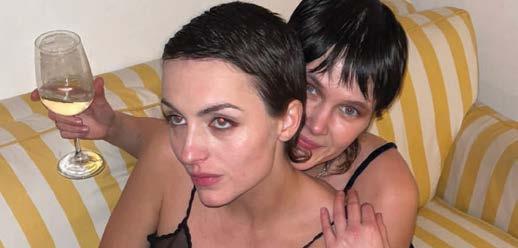






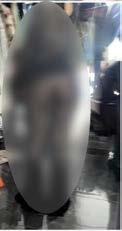










































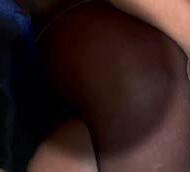





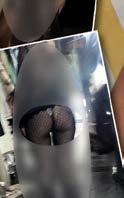













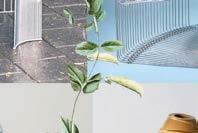







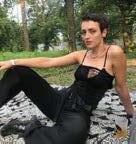



































A personal reflection on the origins, background and vision of Malmö Open Studios, an open studio programme in Malmö, Sweden, by its founder Rina Eide Løvaasen and the new project coordinator Nan Embäck.
There are many reasons why Malmö Open Studios (MOS) was established in 2018. Eight years earlier, the artist Rina Eide Løvaasen had moved from Oslo to Malmö, well aware of what the Oslo Open could mean for Oslo-based artists.1 Two and a half years after Løvaasen left the Malmö Art Academy
1 O slo Open is an independent artist-run non-profit organisation established in 2000 by artists and a number of local and national art institutions. The main task of Oslo Open is organising an annual event where artists from the fields of visual art and contemporary craft open the doors to their studios for one weekend in April. www.osloopen.no
the bubble had burst and reality became quite pressing. She had a lingering feeling that no one knew about the diligent work that was taking place in her studio. There was a duality between being among several hundred thousand people and having the ability to do without a social life, for work was most important and the body shuttled back and forth between the workspace and home.
Being in great company, as the artist’s studios in town have not been short of very good artworks, the greatest accolade given to Malmö as an art city was nevertheless that

it was easy to find peace to work in. Everyone in the Swedish art industry knows that the monetary epicentre lies in Stockholm. Not because the artists there are better, but because presence, personal relationships, and IASPIS play a significant role, because the capital houses more art institutions, exhibition spaces are financially stronger there, and because existing cultural capital attracts more individuals hungry for the same capital.2
Loyal and Elastic (commercial galleries) had moved back to Stockholm, Johan Berggren had stepped down as a gallerist, and with him, the last collector turned their gaze north-east. Not that the commercial market necessarily is the most exciting to engage with; frankly it can be off-putting, but good gallerists are important for the ecosystem of an art scene. They help to keep it vital. The segregation between Malmö and Stockholm felt quite striking. For better and for worse but could we ourselves, the artists, harness Malmö’s strength, its collegiality, and draw the attention back again?
Malmö is a small-big city. At the time Malmö Open Studios was established the art scene was even more fragmented than it is today. The need to become familiar with one’s own art scene became more and more urgent. A curiosity about our own potential grew; could we revitalise our status nationally or maybe even more importantly, regionally?
Malmö Open Studios is a simple concept copied and pasted
2 I ASPIS is the Swedish Arts Grants Committee’s international programme for visual and applied arts. It is aimed at professional artists in the field of visual arts and design with an artistic practice in, for example, visual arts, photography, design, crafts, illustration, textile art or architecture. (www.konstnarsnamnden.se)
from the aforementioned Oslo Open. All professional visual artists and artisans with a studio in Malmö are invited to open their doors to the public. This allows anyone interested the opportunity to visit workspaces that are otherwise closed to the public. Here both finished and unfinished work can be found. Some pieces exist only in the sketch stage while others are models for work that has already been sold.
In addition to inviting the public to visit, we also invite art world professionals for a one-day programme. Here we aim for networking and the potential possibilities that it gives. When skilled practitioners come together, collaborate, and elevate each other, it is a win-win situation. Beyond engaging conversations, the potential for participating artists lies in being invited to participate in exhibitions, public commissions and collections, and to become visible to grant committees – in essence, opportunities for generating income. Strong, economically sustainable artist’s practices have the ability to elevate one’s community in such a collegial environment as we have in Malmö. We share knowledge, offer each other work opportunities. We sustain small, obscure specialty shops and contribute to tax revenues in the south. With financial security the quality of an artist’s oeuvre can improve, benefitting the public, especially on a local scale. When artists can dedicate all their working time to their practice, the work gains a significant potential to improve. The public gains access to better art. At a local level, this production can have effects both externally and internally. Collegially, success can be contagious, akin to a successful cross-country skiing team – one witnesses closely what it takes to succeed, and strives
for it. When this work is then shown locally, minimal emissions are required for transportation. Financial security can thus have positive impacts on the environment, both socially, professionally, and in terms of climate.
Through the project, an overview of visual artists and artisans has been established that did not exist previously.
The Malmö Open Studios non-profit association has 300 members, representing far from all the professional, active artists, and artisans in the city, but nevertheless compiles a quantity that states quite clearly the strength we represent. The majority of these artists do not show their work in Malmö, and even fewer showcase their pieces in venues not primarily targeted towards artists themselves. There are no suitable exhibition spaces here for mid-sized art practices that might not have sufficient recognition for a solo exhibition at one of the three major institutions. This is a significant challenge. One of the aims is to resolve this by establishing the right contacts during MOS, which may create opportunities to showcase the potential of these practices elsewhere. Hence MOS exists so that locals and visitors can establish a relationship with the local art scene, with the artworks being produced here, while at the same time the artists can receive the attention we ought to get.
The involvement of Nan Embäck in Malmö Open Studios began in 2020 when she was an artist participating in the project. It resulted in Nan and her two studio colleagues being invited to exhibit at Sjöbo Konsthall. This happened after moving to Malmö, following her education at the Academy of Fine Arts in Bergen, Norway. The art academy in Bergen facilitated many opportunities to schedule studio visits with visiting artists and professors, offering different
perspectives on art across various disciplines. Seizing the chance, Nan arranged numerous studio visits during the study period, recognising it as an engaging form of interaction.
During the first year at the art academy articulating thoughts about the work proved challenging for her prompting exploration through conversations with fellow artists. Many artists find it difficult to translate artworks, an already existing language of its own, into words be that in conversation or written text. Even when you find the words you might have to rephrase them, since your artworks might gradually change and develop. This is also why a platform such as Malmö Open Studios is so important. The conversations during Malmö Open Studios are about finding common ground, discussing art among the works within the artist’s workspace. The experiences of the interactions vary depending on the person you meet and converse with. Since we invite both art professionals and the general public it contributes to a diversity of approaches to the conversations. With the process being more tangible in the studio where the artworks have been made; it also creates different conversations than those that you might have had in a museum or a gallery. Allowing, within a day, the same luxurious conversational offering as that of an art school.
The role as project coordinator for Malmö Open Studios will continue with Nan, with Rina still engaged. Nan’s goal is for Malmö Open Studios to continue being a consistent and significant element in the cultural life of Malmö. Malmö Open Studios provides opportunities for both emerging and established artists to reach curators, art audiences, and fellow artists, contributing to a more accessible and


enriching cultural life in Malmö. Several artists begin their careers through Malmö Open Studios. After the mentioned group exhibition in Sjöbo, Tove Ambolt, one of the participating artists, also received a group exhibition at OBRA during MOS 2020. In the following year at MOS she was visited by Ebba De Faire and invited to a group show held in Sotheby’s in Stockholm in 2021 and had a solo exhibition curated by Ebba De Faire in 2022. Both Tove and Nan had studied in other countries, in Norway and England, but by participating in Malmö Open Studios, were quickly welcomed into the Swedish art scene after their studies abroad. This is just one of many ways in which Malmö Open Studios has contributed to promoting and establishing artistic careers in the art scene of Malmö.
Each participant invests in the project, aspiring to meaningful interactions, exploration of the unfamiliar, learning from personal or others’ works, and seeking inspiration or emotional resonance. As a new project coordinator the aim for Nan is not to renew Malmö Open Studios but to keep this project going as an important contribution and support to Malmö’s thriving art scene. More interactions between artists, the general public and other art professionals keeps the art scene vibrant and growing!
www.malmoopenstudios.se




For this edition of the magazine we interviewed Seaslug, Stockholm’s youngest and most prolific online (and also a bit offline) art guide with big dreams and a memorable name. How did they start and why, and what are their plans for the future? The founding members of Seaslug Laus Østergaard, Katinka Saarnak, Ali Razzak, and Fanny Bylund answer all our questions. Read on to find out what lies in the heart of a seaslug.
What does a seaslug dream of?
Seaslug : A seaslug dreams of navigating the waters of Stockholm’s art scene in an easier and more accessible way, preferably with their friends and colleagues. To us, a seaslug is flamboyant, or visually appealing. There is something about the movement of a seaslug that we see as a visual representation of navigating. They’re such mesmerising animals, almost like neon signs, we highly recommend spending some time looking up different kinds of seaslugs.
Another important part is that not only do we consider ourselves Seaslugs but also extend that name to our followers and the people who engage with us. For example, we would consider our Instagram followers as Seaslugs. A seaslug is quite amorphous after all.
Why did you choose the name Seaslug?
Seaslug : What appealed to us with the idea of Seaslug is that Stockholm is a maritime city and associated with water – and not only does the seaslug live in water, but it’s also playful, cute, and beautiful.
It was also important that we didn’t want a name that would constrict us. We are a collective and it is about being slugs together. We want to have the possibility to do things in the group without being tied to this calendar or map or guide sort of name. We want to use Seaslug in other collaborative, curatorial, or artistic projects.
Who are the people behind Seaslug?
Ali Razzak : I'm Ali. I work in the data structure side of things. I am a cancer researcher who spends my recreational time coding – often within an art context.
Katinka Saarnak : my name is Katinka, I am a curator and a founding member of Seaslug – we’re all founding members and have formulated the project together. I try to take care of the finances when we have some. Working on keeping it alive and also with social media, among other things.
Laus Østergaard : I'm a curator and an artist, we (Katinka and I) met at the curating art programme at Stockholm University. I’m also a founding member and the chairperson of the board. I contribute to the daily work of social media (as well as Ali)

Fanny Bylund : Artist, regular member, and advisor.
Seaslug : We also have new team members: Lea Gill, who works as a blog editor, and Linda Louise Karlson, a curator who works with our social media.
How are you organised?
Seaslug : We are a non-profit association and we each give approximately one day of work every third week.
Do you work with a budget?
Seaslug : Yes, we do, when we have money.
Where does your financing come from?
Seaslug : Besides our blood, sweat and tears – currently nowhere. We are in the process of finding different kinds of funding (while keeping our site and platform free).
What is your background, both in terms of the motivation behind how Seaslug started and your personal motivations as the individuals running the project?
Seaslug : We were all foreigners to Stockholm, and we had identified that navigating the Stockholm art scene was arduous. And wondered why that was the case because many other cities have established ways of communicating the art to the people. So, in our frustration, we decided to try and address it and we gave birth to Seaslug as a means to connect Stockholm’s art scene to Stockholm City and its people. We wanted to include everything from small artist-run spaces to museums and commercial galleries.
We thought it was a real issue that even though Katinka and Laus were in the curating arts programme and would meet all these cultural workers all over town, they still had no overview of what was going on. If you were interested in going to see exhibitions and openings you would have to subscribe to every single newsletter to get an overview of what’s going on. And honestly, nobody has the time for that.
For example, you could be in the basement of Accelerator art space and not know that there would be an opening there the same evening. It also felt like the information on openings and such were based on messages from friends that would invite you to openings like: “Are you coming to this thing tonight?” And relying on that just doesn’t feel accessible. Basically, the dream was to make it more accessible, inspired by what (art guides etc) other cities already had.
It’s also important to mention that it came out from a need we had - to have it and use it. Fortunately, through the project, we found other people who had yearned for somethingsimilar.
Katinka : When I moved to Stockholm, I had this quite strong urge to get new friends and to get to know the scene fairly quickly and Seaslug felt like a way for me, especially after meeting you guys to be able to do that. I came from Copenhagen and from a place where I was to some extent embedded in the art world in Copenhagen, but I also felt like it was a very elitist art scene that I came from, and I felt detached from it. So I had a very strong wish to not have the same feeling in Stockholm that I had had in Copenhagen, where I felt very alienated and a little bit off when I went to openings and stuff like that. I always felt like it wasn’t my place or my room to
be in, and I think that by starting this project, I, maybe without knowing it, found a way to avoid that happening.
Seaslug : Another important part of Seaslug is bringing the artist-run spaces to the front as well. The art guides and calendars that already existed when we moved to Stockholm would represent the institutions that were paying for their advertising of the exhibitions. Such as this physical calendar that is published twice each year. This demands the exhibition spaces to have everything planned out in good time, which a lot of artists run spaces cannot always do, or they want to leave room for flexibility in their programming. It feels like we offer something completely free and different and the dream is for it to be easy for all parties involved – so that spaces can send us their information easily, and it is also simple for us to share it.
It’s like from the people for the people. It’s very much a service. It’s a big motivator that the goals we set out or the problems that we faced weren’t individual and Seaslug offers a way of solving those problems to more people. A huge motivation has also been hanging out with each other like going to the openings together and having fun with it.
You founded Seaslug in October 2021. And launched your website shortly after in March 2022. So it’s been over two years since the origin. How has the project and your ideas of it transformed during this time? Have you reached all the aims you set out to do in your two-year work plan?
Seaslug : Our goals for the project are still the same today as they were initially. We wanted to create a guide for Stockholm’s art scene where everything, especially in terms of exhibitions, was included. And of course, a lot of things have changed since then, but the main goal is still the same: finding ways of bridging Stockholm people with art.
Initially, there was an idea of doing a simple Google calendar. Then it was built into the website. We’ve since iterated through different designs for how to communicate the website. It’s been fun learning how to structure the project so that it achieves the goals more precisely.
There has also been growth in other ways: the gallery tours and events we do are really exciting because it’s not necessarily calendar-orientated. It’s like not only are we making the calendar, but we’re also in the calendar too sometimes.We’re inside looking out, rather than outside looking in, we’re not like tourists, effectively. Of course, when we started we were outside looking in, but that has changed.
The project has always been DIY but our expectations have changed over time. The approaches to how we would solve issues have changed. We’ve started talking about sustainability within our project and how we can make it easier for everyone involved. What we’ve learned from working on Seaslug is how important it is, when working volunteer-based, to constantly be in the conversation about how to work together in a way where everyone is still engaged in the project because one recurring concern is feeling anxious about your money job. For us, it’s been important to try to avoid Seaslug becoming a chore. Of course, sometimes there are things that you feel a little bit demotivated about. Managing the balance so we don’t get super burnt out and finding ways of being motivated and thrilled, we’ve somehow managed to walk that line.

You (Laus & Katinka) chose to make Seaslug Art Guide as part of your curatorial education project. What is the difference between Seaslug and Seaslug Art Guide? How has the fact that the project was carried out within an academic context affected the way you approached it?
Laus and Katinka : We had been spending quite a lot of time trying to figure out what to do with our MA curatorial project and at some point, we realised that we were spending a lot of time on Seaslug on the side and we figured out that we could buy ourselves a lot of time and a moment to focus on Seaslug by making it our curatorial project through the education. It also gave us a little bit of a budget to work with. So for us, it was an
investment in Seaslug and a way to do things a little bit smarter in terms of time management and work-life balance.
Around the same time was also when we changed the name to Seaslug Art Guide. Seaslug is short for Seaslug Art Guide. Or maybe Seaslug is the collective and then Seaslug Art Guide is the art guide. The Seaslug Art Guide name comes from an idea of being more transparent about what we do and who we are, and also being more accessible to our audience so that they could easily understand what it is that we’re doing.
Seaslug : It’s also important to mention the blog and the celebration. Both of these initiatives were a part of our curatorial project. We still did it collectively, but Laus and Katinka had some more time to invest in those parts. We had a party this summer with the amazing people from Glada Sprutan where we had three performances, one with artist Aske Thiberg, then others with Kulturprofilerna, and dirtbagsandcakes. Creating the blog was something that we had not planned for in the beginning of Seaslug but when we did the exam project, we realised that we missed having some more individual dialogues with our followers. We wanted to talk more about Stockholm’s art scene, wanted to bring in other voices as a collective practice as well. The blog granted us the opportunity to experiment ourselves and to include some of our favourite voices within Stockholm’s art scene. Everyone is welcome to present a project for the blog - we are very open to suggestions.

Was it positively received and supported by the course?
Seaslug : Yes absolutely! While we were doing it we found out that our whole curriculum throughout the programme fitted very well with the work that we had been doing with Seaslug.
You also mentioned a physical guided tour that you did around Stockholm’s galleries. How was this experience in comparison?
Seaslug : It was great – so far it has only happened once, but it was really nice to get to meet some of our sluggers/followers, who use the platform and get to talk about what it’s like going to openings and see exhibitions. It’s like we’ve become experts at going to openings in Stockholm, when we have that expertise, it was fun to share that with others. We have the most knowledge about how to infiltrate the Stockholm art scene. It was also fun to meet our followers and not just engage with them on social media because talking to people on social media can be pretty boring. It’s really important to us that when we go to openings and meet people and mention that we are a part of Seaslug Art Guide, the response is always so great! A lot of our work can be quite boring ‘online labour’, like taking care of our database, gathering and sharing information. It’s really nice getting to meet the ones who appreciate what we do.
It’s a nice way of going into a gallery to be a seaslug – you have a good excuse to be there and almost be like a different character. We still feel that going to openings and exhibitions has a lot of social codes, which can be intimidating. But going as a collective in your seaslug character gives you a nice supportive shield.
How do you see Stockholm’s art scene and your position in it?
Laus : It’s interesting coming from different art scenes of both Bergen and Copenhagen. In Bergen, the commercialised art scene is almost nonexistent, whereas Stockholm has a lot of commercial galleries, for instance. It feels like it’s quite obvious that the commercialisation of the city and public spaces also has moved into the art scene where artist-run spaces are so few.
Ali : I have a slightly different perspective. To me, it is really interesting that there’s kind of a dichotomy in Stockholm art scene where on one side of the street you can have people drinking champagne in suits fawning over some kind of acrylic painting and the other side of the street you can have all the art students hang out in a room. And that to me is really interesting that there is a very big separation. But I do think that the art student room is slowly being consumed by the champagne room and something I’ve been struck by is that the kind of language in Stockholm around art is often tied to investment and commerce, which I understand given Stockholm’s position in Sweden. Although I’ve never lived in a city where the words art and investment have been so close to one another, like in a way, to some people they’re synonyms. However, as the window is closing on the art student room, it is still there. I guess the question is, how do you keep that window open?
Katinka : That was a nice way of phrasing it, from both of you and I agree. Maybe a small way of avoiding this development is to insist on Seaslug as it is; a collective, volunteer-based, free, and inclusive platform. If I was going to say something else about my own position in Stockholm’s art scene, then I think it’s something that’s been changing quite a lot. When I moved to Stockholm I was not sure I wanted to be a part of it. I just wanted to know it. So I think I came with an outsider’s perspective, but of course, to some extent, with the insight of having knowledge about art in general, like having a background in arts. And then I think the longer I lived there, the more I felt like Seaslug became a part of the scene, which meant that we became part of the scene. And I still consider myself a part of Stockholm’s art scene, even though I don’t live there anymore.
Are you happy with your outreach both in terms of contributors and your audiences?
Laus : I think we are happy about it. If we were a big corporate art guide we would probably aim for a higher outreach happening quicker. But luckily we’re not and there’s still plenty of space for us to make mistakes and learn as we go.
Katinka : Yeah, and for us to grow. Of course, we would love some more followers and for people to engage more, especially for people to send us their exhibitions via our online form but at the same time I have really enjoyed the benefits of growing slowly. I remember what a milestone it felt like when we reached 500 followers. It took us months after our first launch. Now we have almost 2500. We have never spent money on promoting our Instagram, so it’s really a natural growth, and the algorithm doesn’t really help – but giving money to a major company like META seems contradictory.
Ali : I’m happy with how it’s going, and I want it to keep going.
And I think there’s much more we have yet to explore. Yeah. I’m optimistic about our prospects.
Moving into the future. What are the plans and visions for Seaslug in the near and far future? Some of you have moved away from Stockholm. How is this, how has this affected your activity? Will Seaslug move on? What are your plans, and visions?
Ali : I think there’s just so much more that I’m excited about in terms of like talking to Glada Sprutan, an artist-run event and atelier space located in Hägersten, talking to Konstforum i Skåne, and collaborating with other districts in Sweden, thinking about how to engage with the community in new ways. Being a base for providing visibility for independent art spaces. Of course, new ideas are always coming up.

Katinka : And then we have always had a vision of receiving funding or finding a way to sustain ourselves financially. We are also in the process of planning another party. It's going to be fun! So yes, Seaslug will live on. But I think at the same time, I also feel like, yes, it has affected our activity in the sense that we don't get out as much as we used to because some of us can’t easily go to the places that we used to anymore. And that of course affects our presence in the city. But, that being said, it doesn't mean that Seaslug will not live on. We would also love to be more in touch with our audience, and do more events, and tours, so we can meet all the slugs out there.
Laus : I think the dream would also be that Seaslug wouldn’t be so dependent on us as individuals, but that it would continue as a collective practice kind of project that could move on to new people and that they would hopefully in the future feel free to use the platform, experiment with what Seaslug Artguide and Seaslug is. I think the future is bright.
Ali : That’s a good footnote in terms of sustainability. I guess the big two overarching aspects are the distribution of labour in terms of a finite time, and the resources to compensate for that labour and I guess for the latter point the solution is to aggressively, embarrassingly, and boldly apply for as many grants as we can and see how that turns out.
seaslug art guide www.seaslug.se
MARKUS ÖHRN & AZDORA
Requiem för Eva-Britt
1 MAJ 16 JUN FRIDA ORUPABO 28 AUG 10 NOV
KSENIA PEDAN 28 AUG 10 NOV
MARIA BONNIER DAHLINS STIFTELSES
STIPENDIATER 2024 DEC JAN 2025

At some moment during the mid-to-late-90s, prior to changing titles from aspiring filmmaker to aspiring visual artist, I arrived at the realisation that the vertical hierarchies within the television, film and commercial industries didn’t suit my temperament. The inkling of doubt that existed earlier in my ‘career’ had become an undeniable truth over time. By fall of 1999 I would find myself in graduate school studying fine art at a local university.
As a naive, aspiring artist, I remember going to art openings and parties, and randomly talking to fifty-something year old artists who I assume had stacks and stacks of paintings in their studios with little or no exhibition history. If you allow me to paraphrase, they would often grumble about how crappy the art world is, and that those people
(whoever “those people” might be) were too shallow and dumb to understand the groundbreaking magnitude of their work. I remember telling my twenty/thirty-something year old self, “No matter what happens, I never want to be like these dudes when I grow up.”
In those moments, I made the decision not to wait for some gallerist or curator to wave their magic wand and pave the road to success for me, and decided I would take matters into my own hands. Flash-forward a couple decades, and now I too am a fifty-something year old artist (yikes!), and although I’m not sure I’ve produced anything of groundbreaking magnitude, I declare with zero hesitation and a sigh of relief, that I have indeed had some exhibition history since the late 90s.
and Ray booth at QiPO Fair 02, 2020
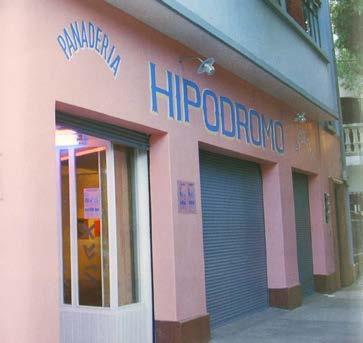

1 Artists and co-curator of ‘Catastróphico’ group exhibition at La Panadería. Curated by Ichiro Irie and Paola Santoscoy. From left to right: Horacio Cadzco, Gustavo Artigas, Paola Santoscoy, Artemio, Valeska Peschke, Lucy HG, Lisa Blas and Satoshi saegusa.
2 Exterior view of La Panadería. The Mexico City artist-run space started by artists Yoshua Okón and Miguel Calderón. The apartment on the second floor served as a residency where Ichiro Irie made his home for his first year in Mexico between 2001 and 2002.
3 RiM magazine, various covers. An independent contemporary art magazine founded and edited by Ichiro Irie.
When I first started though, I and my cohort of like-minded and not-so-like-minded artists had to make everything happen from scratch with zero outside support. The term “DIY” was not yet part of our vocabulary (the acronym became integral to our popular lexicon shortly after the late 90s internet explosion). There we were, planning, installing and promoting our small-time exhibitions by passing out self-made postcards at other people’s shows and distributing press releases through this brand-new technology called email. By the time I had finished graduate school, I had organised or co-organised a good dozen or so shows at the prerequisite local cafes, a warehouse studio run by an S&M couple, a metal design studio, one at my house, and a few artist-run spaces. At one of the cafes, I fell backwards from a twelve-foot ladder and landed my ‘where the sun doesn’t shine’ right on the corner of a wooden table (yes, it hurt).
I became a fixture at a now defunct artist-run space called The Hatch located in LA’s West Side where the director, Christopher Sicat, let me curate a couple of shows. The Hatch is where I first cut my teeth as a fledgling member of the LA artist-run community. During this time I also met Max Presneill, the then director of the artist-run space Raid Projects. Many of you who travel in artist-run circles may know him as the Director/Curator at Torrance Art Museum and founding member of Durden and Ray. Since the early naughts, we’ve exchanged resources, connections and opportunities, and experienced our share of triumphs and defeats.
In September 2001, right after grad school, I moved to Mexico City through a Fulbright Fellowship. What was supposed to be a one-year residency turned into a five-year journey where I showed my work, met my future spouse, had a child, and organised a flurry of exhibitions. One of those spaces was La Panadería, the legendary artist-run space established by artists Yoshua Okón and Miguel Calderón. For my first year, I lived in the apartment on the second floor of this bakery turned contemporary art venue. In Mexico, I got to know artists like Okón, Calderón, Teresa Margolles and Pedro Reyes, met at least in passing several more like Damien Hirst, Mario García Torres and Gabriel Orozco, not to mention ultra-famous celebrities like Gael García Bernal and Julieta Vengas. All made possible in large part, thanks to La Panadería directors at the time, Paola Santocoy and artist/ filmmaker, Artemio. Without them, my residency in Mexico City would have been a much less spirited one.
About half a year after I had moved to Mexico, and almost on a whim, I started an independent art publication called RiM magazine. The first issue came out in the Spring of 2002. My initial idea was to steer the dialogue away from a North Atlantic centred one (i.e. New York and Western Europe) to one that encompassed geographies and communities around the Pacific such as the West Coast of the United States, Latin America, The Pacific Islands and Asia. It was an enormous and lofty mission that I didn’t quite accomplish, but without any prior experience or road map, my collaborators and I managed to produce a total of fifteen quarterly issues (a gap or two here and there) with the generous support of Cultural
Contact, the Jumex Foundation and Patronato de Arte Contemporáneo.
After having spent four years in Mexico City, knowing that I would be leaving within a year, I started asking around for somebody who could take the mantle of handling the laborious task of editing and publishing an art magazine for zero financial gain. An art historian named Luz Sepulveda introduced me to her former students, recent graduates at La Universidad Iberoamericana. They were Mariana González, Macarena Hernández, and Laura Reséndiz. During my last year in Mexico City, they would take the helm of RiM magazine.
Of particular importance for our story is Laura who had since assumed a number of roles in the fields of visual art and publicity. Perhaps most prominently, she became partner and director of Anonymous Gallery, a mid-sized commercial gallery she co-directed between the years 2011 and 2016. Around 2015, becoming increasingly disillusioned by the commerce side of the art world, she began working in the realm of social practice. Under the moniker of CICLO (later rechristened CICLO Arte para todos), Laura worked in conjunction with underserved communities utilising her expertise as a visual arts professional in a capacity that she considered at the time more impactful and fulfilling than anything she had done prior. Laura would soon transition to CICLO on a full-time basis, laying the foundation for what would become the first iteration of QiPO Fair in 2019.

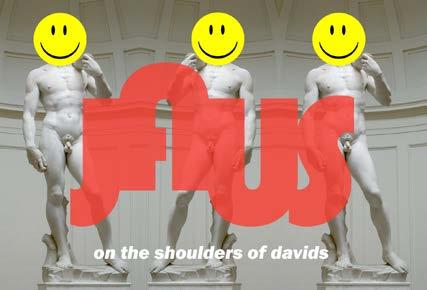


In August of 2006, I returned to Los Angeles and within a few months found myself employed at a gallery in Beverly Hills. No more than six months had gone by when I realised (considerably faster than my friend Laura) that I was not cut out for commercial gallery work. Fortunately, by the summer of 2007, I was offered work teaching art at the community college level. While maintaining my own studio practice and exhibition schedule, I had also curated at venues such as Torrance Art Museum, 18th Street Arts Center, Santa Monica, Campbell Works, London, and Tiger Strikes Asteroid, NY.
While teaching, raising a child, being an artist and putting together shows featuring other artists, it occurred to me that I would like to run my own artist-run space where I could concentrate my curatorial energies under one roof. My family moved to a property in West LA and we transformed a section of the backyard into a sixty square metre exhibition space.
In September of 2009, we opened JAUS (pronounced “house”) with a show called, ‘On the Shoulder of Davids’ featuring more than thirty artists that had at one point or other operated or helped operate their own artist-run spaces. As a reference to the story of David and Goliath, instead of standing on the shoulders of giants, I imagined JAUS to be standing on the shoulders of all the proverbial Davids, the artist-run spaces that would challenge the big bad Goliaths of the art world.
My first experiences with an artist-run art fair happened in 2011 and 2012 when JAUS was invited to participate in the Co/Lab I & II fairs organised by the members of ARTRA Curatorial, led at the time by Max Presneill, Kio Griffith and associates. Both editions happened within a smaller section of the Art Platform Los Angeles fair which came and went after two editions. At that time if someone asked me if I’d be interested in organising my own fair some day, I would have immediately answered, “No fucking way.”
The second experience happened in 2015 through Alex Paik, founding director of Tiger Strikes Asteroid. I had just arrived at their New York venue to install ‘Hysterical Friction’, an exhibition documenting the history of JAUS as a works on paper show. Upon arrival, Alex told me about an art fair he would be organising as part of the first edition of the Satellite fair in Miami. The event would be aptly titled
‘Artist-Run at the Satellite Show’. As much carnival as art fair, and at three-hundred bucks per exhibitor for a beat up North Beach hotel room, artists were free to explore their creative muses in any way they saw fit without having to worry so much about sales, injuries to their pocketbooks, or damage to the already deteriorated building. More than a few publications including Two Coats of Paint, Art F City, BMoreArt and Huffington Post agreed that it was a refreshing alternative to the bigger, glitzier fairs a few miles south.
JAUS closed its brick and mortar operation in mid-December 2018 and now only exists as a sporadic nomadic project, on social media, and hopefully in everyone’s hearts and minds. Bringing things full circle, Alex, who now lives in Los Angeles, invited me to become a member of Tiger Strikes Asteroid Los Angeles in 2021.
1
Exterior view of JAUS. Mural by Mark Dean Veca. Fire sculpture installation by Kiel Johnson. JAUS was an artist-run space Ichiro Irie started in his backyard in West Los Angeles in September 2009. The brick and mortar closed in December 2018.
2
Installation view for for ‘On The Shoulders Of Davids’, 2009. The first exhibition at JAUS featured over 30 artists who operated or helped operate their own artist-run spaces.
3
Postcard invitation for ‘On The Shoulders Of Davids’, 2009. The first exhibition at JAUS featured over 30 artists who operated or helped operate their own artist-run spaces.
4
Exterior view of JAUS. Vinyl floor installation by Shinpei Takeda. JAUS was an artist-run space Ichiro Irie started in his backyard in West Los Angeles in September 2009. The brick and mortar closed in December 2018.

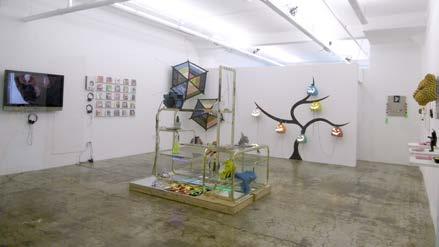




In 2016, Ville Laaksonenn, a Finnish artist/curator who had previously participated in a Swedish and Finnish painting show at JAUS, asked me if I would be interested in doing an exchange exhibition, one at Titanik-galleria in Turku, Finland, and another at a yet-to-be-decided spot in Los Angeles. He told me that the catch would be that some kind of curatorial group based in the U.S. would have to be attached to the project in order to be eligible for Finnish funding. I talked to my friend Kio Griffith and he suggested that we create our own curatorial group. For the Finland show I suggested the concept of collaboration as a loose overarching theme. Now we just needed some artists, a title for the show, and a name for our newborn group. Kio came up with the name ‘Lazy Susan’ as the exhibition name, referring to those rotating discs that sit in the middle of large, circular tables at Chinese restaurants. Perfect. We also invited a stellar group of artists. Done.
After some brainstorming and deliberation, I suggested the name QiPO (pronounced “key-poh”) as a bastardisation of the Spanish word ‘equipo’. ‘Equipo’ has multiple definitions in Spanish including team, and equipment. This could refer to an athletic team or a committee within a larger organisation. Equipment could refer to I.T. equipment or a bunch of tools necessary for an art installation. We removed the letter ‘e’ that sits in front of many Spanish words such as ‘estrella (star)’, or ‘estudio (studio)’, and also removed the silent ‘u’ resulting in a disyllabic, four-letter word, ‘q-i-p-o’. We thought this neologism would be relatively easy to remember, easy to say in any language, easy to Google without much ambiguity, and had a sympathetic sound and look that would surely charm our public.
From the onset, our mission has been thus: ‘QiPO is a team of international curators, artists and cultural producers who have joined forces to realise exhibitions, events and various arts related projects around the world with the purpose of promoting dialogue and social engagement.’ After the Finland leg, we organised the L.A. counterpart at Arena One gallery, Santa Monica, and also went on to organise group shows in Bogotá de Colombia, an LA/SD/TJ show at San Diego Art Institute, and a show featuring Japanese and American artists at PØST LA. The question now was where to go from there.
1 Exterior view of opening reception for ‘Lazy Susan’ group show, curated by Ichiro Irie and Kio Griffith for QiPO collective at Titanik-galleria, Turku, Finland, 2016. The first ever QiPO collective project.
2 Long Long and the Kellies performing at San Diego Art Institute (SDAI) as part of ‘Boiling Process: Mythodologies’ programming, 2017.
3 Installation view of ‘Undisrememberable Curios’ group exhibition featuring artists from Japan and USA curated by Ichiro Irie for QiPO collective at PØST, Los Angeles, 2018.
4
Installation view of ‘Fin_Between’ group show, curated by Ville Laaksonen for QiPO collective at Arena 1, Santa Monica, 2016.
5
Installation view of ‘Boiling Process: Mythodologies’ group show, curated by Ichiro Irie for QiPO collective at San Diego Art Institute (SDAI), 2017.
6 Social media banner for QiPO at Tryst Alternative Art Fair. Tryst is a project spearheaded by Max Presneill, Director/Curator at Torrance Art Museum. Tryst is a project of Torrance Art Museum and the city of Torrance, CA.


I started ruminating about the possibility of putting together an art fair of sorts in 2016 when I was invited by Colombian artist Carlos Blanco to help him organise a big event at Estudio Las Nieves, a multistory studio complex in downtown Bogota during their art fair week. The idea was to pair Colombian artists with suitable LA-based artists and activate the entire building as a single event. Although Carlos himself was into the idea, he couldn’t get the other Colombian artists on board, so we ended up doing a smaller project in his personal studio.
A couple years later, during the summer of 2018, the director of a smaller LA based art and photo fair approached me about helping him organise something that would amplify the scope, attendance and profile of his event.
To get some input and advice regarding if and how I should go about putting together an art fair for alternative spaces, I consulted with Max Presneill who has organised the Co/Lab fair, Alex Paik who directed the Artist-Run/Satellite fair and Brett Schultz who to this day runs Material Art Fair in Mexico City. Along with being the founding director of Material, I knew Brett as the gallery director of Yautepec where I had a 2009 solo exhibition. JAUS also participated in Material Art Fair in their 2016, 2017 and 2018 editions.
Brett and Alex both said the same thing, “Don’t do it.”
They both said in separate conversations that putting together the first editions of their respective fairs was extremely stressful even with the extra time and resources they had at their disposal. The only one who said, “Yeah, do it,” was Max, and even offered to help, but also advised that I needed to make sure the parent fair director was willing to allocate enough square footage and wall space for our part of the production.
In the end, mostly due to unrealistic time constraints, I aborted the ‘art fair for artist-run initiatives’ concept and organised ‘Skulpturengarten,’ an indoor sculpture garden featuring twenty large-scale freestanding works by twenty emerging to established artists. Although nothing resembling a fair manifested itself with my name attached to it yet, I think my unconscious mind was somehow willing it into existence.
1 Installation view of ‘Skulpturengarten’, group pop-up exhibition at The Reef, LA.
2 Installation view of ‘Skulpturengarten’, group pop-up exhibition at The Reef, LA.




1 QiPO [fair] 01, 2019 (before restoration). One of the two storefront spaces we used.
2 QiPO [fair] 01, 2019 (after restoration). The same storefront after restoration.
3 QiPO [fair] 01, 2019 team, Ichiro Irie (Creative Director), Laura Reséndiz (Executive Director), and Horacio Cadzco (Production Director) in front of the QiPO 01 banner
4 Opening night reception of QiPO [fair] 01, 2019
In early December 2018, my friend Laura Resendiz from Mexico City, the one who went from gallery owner to social practice organiser, and now a member of the QiPO collective, contacted me about an opportunity. She had recently started working with Reurbano, a real estate development group in Mexico City that had the goal of making the downtown area more livable with the arts serving a central role in their mission. She told me that the storefront sections of a building from the early 1900s located within a couple blocks of Material Art Fair and Salón Acme (two of the three biggest art week events) would be available for us during that time.
Aside from the severely limited time window, it sounded like an excellent offer. Doing a simple Google search, I could see the facade of the impressive neo-colonial building situated in front of El Reloj Chino (The Chinese Clock), another historical monument gifted to Mexico by the last Chinese emperor. I agreed to co-organise the event with her under four conditions:
1) t hat there be twenty-four hour security.
2) t hat there be functioning electricity in the spaces we would be using.
3) t hat there be a functioning restroom with running water.
4) t hat I see detailed photos of the venue as soon as possible.
If those conditions were met, we would put on an amazing show. We didn’t hear anything back from our contact for three weeks because in Mexico, everyone leaves the city during the winter holidays, the building management included.
In the meantime, we decided the event should be called QiPO 01. We didn’t call it QiPO Fair yet, because it felt at the time more like a curated group show that happened to involve artist-run spaces, and frankly we only had a vague idea of what it would end up looking like.
We finally received notice from our building contact in the beginning of January 2019, about five weeks before the show would theoretically open. They told us that yes, there would be twenty-four hour security, yes, there would be electricity, and yes, there is running water and restrooms, but we would have to wait to see if the restrooms were currently functioning. I thought, “Heck, if they aren’t working we will just get them fixed, no problem.”
Then came the photos.
I am not exaggerating when I say on the outside the building looked like a dream come true, but on the inside the rooms looked like the aftermath of a haunted house after a drone strike. In every photo all I saw was a thick accumulation of dust on the floor, layers of peeling, dilapidated paint, cracked plaster and brick with an assortment of gauges, broken shelves, cabinets and wires sticking in and out of the walls. Don’t ask me what I was thinking, but after a few hours of contemplation, I called Laura and told her, “Yeah, let’s do it.”
I immediately started contacting my colleagues who ran artist-run spaces, who were members of artist or curatorial collectives, or managed smaller project spaces. I told them about the situation as clearly and honestly as possible, and asked if they could contribute in order to turn House of Usher into an adequately dignified exhibition venue. To my great surprise, most of them replied, “Yeah, let’s do it.”
Then, after a few days, we were informed that one of the storefront spaces offered to us was no longer available, and that we would have to use another space that was previously occupied by an auto mechanic. To my horror and chagrin, the entire floor of the shop was sectioned off by long and damaged strips of concrete about fifteen centimetres off the ground used to elevate vehicles in need of repair. I told Laura that in no way, shape, or form we could have ladies wearing high heel shoes coming to our art show walking across that uneven terrain. To make matters worse, the building did have running water and restrooms, but where the two toilet bowls should have existed, we discovered two round holes in the ground and tubes sticking out of the wall.
A word of advice: one should not organise four-day art events without a restroom. You can’t have exhibitors sitting in their booths more than six hours a day for four days straight with no available lavatories. It goes against all that is good and decent in this world. By the time we figured this out, half our exhibitors had purchased their airline tickets already so there was no turning back. To say I was absolutely mortified would be an understatement. I told Laura, “Even if we have no lights, no walls and no art, we can’t have our event without at least one, ideally two bathrooms.” She agreed.
With nowhere to turn, I called my best friend, Horacio Cadzco, an artist who had been working in the areas of art




direction and production coordination for events and media productions in the area. To make a very, very, very long story short, Horacio fixed everything. It required a lot of moving, tossing, scraping, scrubbing, mopping, many sheets of drywall and a boatload of white paint, and it did cost us a few more pesos than we budgeted for, but we did it. By the time all the exhibitors and their artists arrived, everything was in order, they were all happy with their booths, floors were evened out, restrooms were operational, and everything was good to go.
Then, three hours before the opening, the art gods decided to throw us another curve ball. For what can only be described as a sadistic twist of fate, the electric company arrived and cut off all the electricity on our block. We explained to the gentleman who was in charge of the crew the nature of our event and begged him to turn it back on until Monday, but he wouldn’t budge. He was following strict orders.
Another word of advice: one should not organise four-day art events without electricity. At that brief moment in time, my only wish in life was that the art gods throw a bolt of
lightning at my head and put me out of my misery. Instead, Laura and Horacio called the Reurbano, and they arrived at the nick of time, sorted things out with the electric company and saved the day. They even brought over a generator in case something bad happened again. By the end of the evening, Reurbano, the exhibitors, the artists, our staff and volunteers, Laura and I were all smiles. We had so many visitors and much more press than we expected from local and national publications.
Sunday night after everyone finished de-installing, a group of us had dinner at a nearby cantina. I don’t think I ever laughed so hard. More than the sense of relief after surviving the whole ordeal, I felt like we accomplished something substantial with and for our peers. But most of them are invited to participate in far more auspicious exhibitions, so that wasn’t quite it. It was the opportunity to bring a lot of people together who might have never met each other or worked together, and to create something that was unique and, I believe, worthy of people’s attention. All from the ground up.
Respectively as self-ordained Executive and Creative Directors, Laura and I organised the event the following year in a different area of the same building. We made it an open call and decided to call it QiPO Fair.
On 10 February 2020, after the final day of the fair, Laura and I met with an American journalist at a café, and she asked us, “So, what do you think of that virus?” At the time, I shrugged it off, and thought it was just another exaggerated scare like Ebola or SARS that would never reach the Americas. She countered, “I’m a little worried because my father, who has never worried about anything like that before, is very worried about this one.”
Needless to say, the journalist’s father was right and I was wrong. We skipped 2021 altogether, and in 2022 did a socially distanced outdoor event called ‘QiPO PRESENTA’. In 2023, we came back with a bang, this time occupying the ground level of a brand new apartment complex across the street from our previous location; both shows thanks to our friends at Reurbano.
Meanwhile, I had been hearing about the Swedish art fair, Supermarket – Stockholm Independent Art Fair, ever since I made a remote contribution to a project Ville Laaksonen organised in 2016. Max, who has just started his own Tryst Alternative Art Fair, always spoke highly of Supermarket as well. The opportunity to visit finally arrived in 2023 when Tiger Strikes Asteroid Los Angeles let me apply as one of their members. I wanted to visit Stockholm in person, participate in the fair, and learn first hand how the pros do it. The pros did not disappoint.
With steady growth QiPO has had exhibitors from Los Angeles, New York, Sacramento, Berlin, Helsinki, Tokyo, Bogota, Mexico City, and various cities from the Mexican republic as well. By the time you read this, the 2024 edition will have been our biggest event with over thirty exhibitors. Our plan is to grow slowly but steadily, and we hope to someday become the premiere event for artist-run spaces in this hemisphere, kind of like what Supermarket has become for Europe.


Vi har försäkrat konstnärer, konsthantverkare, illustratörer och designers sedan 50 år. Besök gefvert.se eller ring oss på 08-440 54 40 så ser vi över just dina behov.


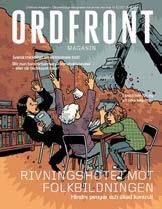



En tidskrifts bästa vänner är prenumeranterna. Var en vän – i hårda tider behöver vi er mer än någonsin!
Vi ger också dig som prenumerant mer än någonsin. Du får den tryckta tidskriften hem, och tillgång till vårt digitala arkiv, som just nu går hela vägen tillbaka till 2004.

Ord&Bilds 2024 går helt i de fyra elementens tecken. Häng med!
Helår 400 kr, autogiro 33 kr i månaden. www.tidskriftenordobild.se/prenumerera

